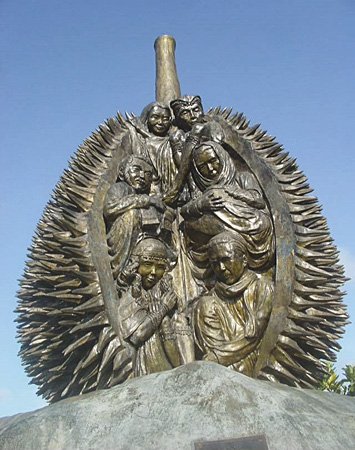Cultural Center of the Philippines
ENCYCLOPEDIA OF
PHILIPPINE ART
The Durian
2003 / Concrete / Height 1,219.2 cm / Artist: Kublai Millan / Davao International Airport, Sasa, Davao City
The Durian by Rey Mudjahid Ponce Millan aka Kublai (b. 1974) is a 1,219.2 cm (40 ft) sculpture in concrete installed at the entrance of the Davao International Airport in Sasa, Davao City. It was unveiled on 15 Mar 2003. The work was commissioned by AJMR Holding Company Inc under Alberto M. Soriano and dedicated to the matriarch Doña Carmen Marfori Soriano.
Consistent with the body of work of the artist, this piece of public art towers over the surrounding landscape. The concrete sculpture shows a halved durian fruit with six people nestled inside it, in lieu of seeds. The durian grows abundantly in Davao, which is well-known for its durian-related products. The six people birthed inside this sculptural piece are paired representations of the three major groups inhabiting Mindanao: the indigenous peoples, the Muslims, and the Christian settlers. This is consistent with Kublai’s recurrent representations of the Mindanao tri-people population.
More of Kublai’s monumental concrete pieces can be seen in the People’s Park in Davao; in the Overview Park in Bukidnon; in the Saranggani farm of Philippine boxer Manny Pacquiao; in a retreat house in Mount Apo National Park in Kapatagan, Davao del Sur; in a cathedral in Tagum, Davao del Norte, in Panabo, Davao del Norte; in Sultan Kudarat in Maguindanao; in Surallah, South Cotabato; at the Enigmata Treehouse in Camiguin island; and around the family-owned Ponce Suites Hotel in Davao City. In 2010, the artist was also commissioned by the Vatican to do a nativity scene for Saint Peter’s Square. Versions of the durian piece constitute other works of Kublai, such as the one in Ponce Suites where there are six ladies instead of the tri-people. The tri-people images are also seen in his Nativity piece for the Vatican, in a work titled You in Kapatagan, and in the monument at Surallah.
The sculptor sees himself as an advocate of Mindanao art and culture. In a Philippine artistic and cultural landscape where the regional is pushed to the background, the artist has succeeded in getting noticed. He does this through these massive sculptural pieces, usually done in partnership with local government units and other institutions. He continues to undertake several commissions from tourism boards and churches to create public art around Mindanao.
Written by Kelly P. Ramos
Sources
Chi, Angely. 2014. Interview.
Gallery Big. 2014. Kublai Millan. http://gallerybig.com/gallerybigkublai.html. Accessed 22 Jun 2014.
Newslink TV. 2011. “Kublai Millan: The Man Behind the Artist.” Posted May. Accessed 22 Jun 2014. http://newslinktv.blogspot.com/2011/05/kublai-p-millan-man-behind-artist.html.
Pastor, Pam. 2010. “Kublai and His Mighty Sculptures.” Inquirer.net, 25 Dec. http://lifestyle.inquirer.net/super/super/view/20101225-310859/Kublai-and-his-mighty-sculptures.
Villaraza, Pi. 2008. “Creative Spaces.” Cebu Pacific website. Accessed 22 Jun 2014. http://www.cebusmile.com/features/2008/11/creative-spaces.
